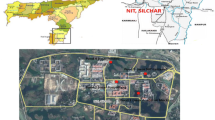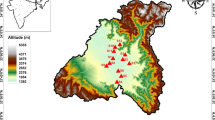Abstract
The purpose of this study was to examine the role of geological, hydrological, and anthropogenic factors in structuring periphytic algal assemblages in the rivers of the Lake Ladoga basin (Northwestern Russia). Canonical correspondence analysis (CCA) conducted on spring dataset showed that water temperature, color, and river morphology were primary factors shaping the structure of algal assemblages during the spring post-flood period. CCA on summer and autumn dataset revealed that conductivity and total phosphorus were the most important variables during the base flow period. Cluster analysis carried out on algal assemblages separated all rivers into two main groups that corresponded to the two geomorphological regions of the Lake Ladoga basin: the northern and the southern sub-basins. The separation of the northern and the southern groups were best explained by the pattern of conductivity reflecting geological and land use differences in the watersheds. The values of the Specific Pollution sensitivity Index (IPS) and the Biological Diatom Index (IBD) were higher, indicating better water quality, for rivers of the northern sub-basin than for rivers of the southern sub-basin. Mean values of the IPS and IBD for rivers of the northern and the southern sub-basins varied within the boundaries of a good water quality.





Similar content being viewed by others
References
Ács, É. & K. T. Kiss, 1993. Effects of the water discharge on periphyton abundance and diversity in a large river (River Danube, Hungary). Hydrobiologia 249: 125–133.
Ács, É., K. T. Kiss, K. Szabó & J. Makk, 2000. Short-term colonization sequence of periphyton on glass slides in a large river (River Danube, near Budapest). Algological Studies 100: 135–156.
Anagnostidis, K. & J. Komárek, 1988. Modern approach to the classification system of Cyanophytes. 3 – Oscillatoriales. Archiv für Hydrobiologie Supplement 80, Algological Studies 50–53: 327–472.
Barinova, S. S., L. A. Medvedeva & O. V. Anisimova, 2006. Diversity of Algal Indicators in the Environmental Assessment. Pilies Studio, Tel Aviv (in Russian).
Biggs, B. J. F., 1995. The contribution of flood disturbance, catchment geology and land use to the habitat template of periphyton in stream ecosystems. Freshwater Biology 33: 419–438.
Biggs, B. J. F. & R. A. Smith, 2002. Taxonomic richness of stream benthic algae: effects of flood disturbance and nutrients. Limnology and Oceanography 47: 1175–1186.
Biggs, B. J. F. & H. A. Thomsen, 1995. Disturbance of stream periphyton by perturbations in shear stress: time to structural failure and differences in community resistance. Journal of Phycology 31: 233–241.
Biggs, B. J. F., R. J. Stevenson & R. L. Lowe, 1998. A habitat matrix conceptual model for stream periphyton. Archiv für Hydrobiologie 143: 21–56.
Borcard, D., P. Legendre & P. Drapeau, 1992. Partialling out the spatial component of ecological variation. Ecology 73: 1045–1055.
Cao, Y., D. D. Williams & N. E. Williams, 1998. How important are rare species in aquatic community ecology and bioassessment? Limnology and Oceanography 43: 1403–1409.
Cemagref, 1982. Etude des Méthodes Biologiques d’Appréciation Quantitative de la Qualité des Eaux. Rapport Division Qualité des Eaux Lyon – Agence financière de Bassin Rhône-Méditerranée-Corse, Pierre Bénite. Cemagref, Lyon: 218 pp.
Dufrêne, M. & P. Legendre, 1997. Species assemblages and indicator species: the need for a flexible asymmetrical approach. Ecological Monographs 67: 345–366.
Hillebrand, H., C. D. Durselen, D. B. Kirschtel, U. Pollingher & T. Zohary, 1999. Biovolume calculation for pelagic and benthic microalgae. Journal of Phycology 35: 403–424.
Kelly, M. G., A. Cazaubon, E. Coring, A. Dell’Uomo, L. Ector, B. Goldsmith, H. Guasch, J. Hürlimann, A. Jarlmann, B. Kawecka, J. Kwandrans, R. Laugaste, E.-A. Lindstrøm, M. Leitao, P. Marvan, J. Padisák, E. Pipp, J. Prygiel, E. Rott, S. Sabater, H. van Dam & J. Vizinet, 1998. Recommendations for the routine sampling of diatoms for water quality assessment in Europe. Journal of Applied Phycology 10: 215–224.
Kolkwitz, R. & M. Marsson, 1908. Ökologie der pflanzlichen Saprobien. Berichte der Deutschen Botanischen Gesellschaft 26: 505–519.
Komárek, J. & K. Anagnostidis, 1986. Modern approach to the classification system of the Cyanophytes. 2 – Chroococcales. Archiv für Hydrobiologie Supplement 73, Algological Studies 43: 157–226.
Komulaynen, S. F., 2004. Ecology of Attached Algal Communities in Small Rivers of East Fennoscandia. Karelian Research Center, Russian Academy of Science, Petrozavodsk (in Russian).
Komulaynen, S., 2007. Short- and long-term changes in phytoperiphyton structure and production in small streams of eastern Fennoscandia. Oceanological and Hydrobiological Studies 36 (Supplement 1): 189–198.
Krammer, K. & H. Lange-Bertalot, 1986–1991. Bacillariophyceae. In Ettl, H., J. Gerloff, H. Heynig & D. Mollenhauer (eds), Süsswasserflora von Mitteleuropa, Vol. 2/1–4. G. Fischer Verlag, Jena.
Lecointe, C., M. Coste & J. Prygiel, 2008. OMNIDIA version 5.2 software for diatom-based water quality assessment. CD-ROM.
Leira, M. & S. Sabater, 2005. Diatom assemblage distribution in Catalan rivers, NE Spain, in relation to chemical and physiographical factors. Water Research 39: 73–82.
Lenoir, A. & M. Coste, 1996. Development of a practical diatom index of overall water quality applicable to the French National Water Board Network. In Rott, E. (ed.), 2nd Workshop on Algae for Monitoring Rivers, 18–19 Sept 1995, Studia Student. G.m.b.H., Innsbruck: 29–43.
Lim, D. S. S., C. Kwan & M. S. V. Douglas, 2001. Periphytic diatom assemblages from Brathurst Island, Nunavut, Canadian high arctic: an examination of community relationships and habitat preferences. Journal of Phycology 37: 379–392.
Moore, J. W., 1977a. Seasonal succession of algae in a eutrophic stream in southern England. Hydrobiologia 53: 181–192.
Moore, J. W., 1977b. Seasonal succession of algae in rivers. II. Examples from Highland Water, a small woodland stream. Archiv für Hydrobiologie 80: 160–171.
Moshkova, N. A. & M. M. Gollerbakh, 1986. Green Algae (Ulotrichophyceae). Freshwater Algae of the USSR, Vol. 10 (1). Nauka, Leningrad (in Russian).
Nikitinskij, Y.Y., 1912. Biological Survey of Moscow River and its Large Tributaries between Town Zvenigorod and Water-pump Station Rublevskaya. Moscow (in Russian).
Palmer, M. W., 1993. Putting things in even better order: the advantages of canonical correspondence analysis. Ecology 74: 2215–2230.
Pienitz, R. & J. P. Smol, 1993. Diatom assemblages and their relationship to environmental variables in lakes from the boreal forest-tundra ecotone near Yellowknife, Northwest Territories, Canada. Hydrobiologia 269–270: 391–404.
Pienitz, R., J. P. Smol & H. J. B. Birks, 1995. Assessment of freshwater diatoms as quantitative indicators of past climatic change in the Yukon and Northwest Territories, Canada. Journal of Paleolimnology 13: 21–49.
Potapova, M. & D. F. Charles, 2007. Diatom metrics for monitoring eutrophication in the rivers of the United States. Ecological Indicators 7: 48–70.
Pouličkova, A., M. Duchoslav & M. Dokulil, 2004. Littoral diatom assemblages as bioindicators of lake trophic status: a case study from perialpine lakes in Austria. European Journal of Phycology 39: 143–152.
Raspletina, G. F. & O. M. Susareva, 2006. Geographic and economic-geographic characteristics of the Lake Ladoga catchment area. In Trifonova, I. S. (ed.), Assessment of Ecological Condition in Rivers of the Lake Ladoga Basin Using Hydrochemical Characteristics and Structure of Hydrobiocenosis. Lema, St. Petersburg: 6–11 (in Russian).
Raspletina, G. F., T. P. Kulish & T. N. Petrova, 2006. Hydrochemical characteristics of the Lake Ladoga tributaries and the Neva River. In Trifonova, I. S. (ed.), Assessment of Ecological Condition in Rivers of the Lake Ladoga Basin Using Hydrochemical Characteristics and Structure of Hydrobiocenosis. Lema, St. Petersburg: 11–35 (in Russian).
Reavie, E. D. & J. P. Smol, 1997. Diatom-based model to infer past littoral habitat characteristics in the St. Lawrence River. Journal of Great Lakes Research 23: 339–348.
Rimet, F., L. Ector, H. M. Cauchie & L. Hoffmann, 2004. Regional distribution of diatom assemblages in the headwater streams of Luxembourg. Hydrobiologia 520: 105–117.
Rothfritz, H., I. Jüttner, A. M. Suren & S. J. Ormerod, 1997. Epiphytic and epilithic diatom communities along environmental gradients in the Nepalese Himalaya: implications for the assessment of biodiversity and water quality. Archiv für Hydrobiologie 138: 465–482.
Rusanov, A. G., E. V. Stanislavskaya & É. Ács, 2009. Distribution of periphytic diatoms in the rivers of the Lake Ladoga basin (Northwestern Russia). Acta Botanica Croatica 68: 301–312.
Semenov, A. D. (ed.), 1977. Guidebook on Chemical Analysis of Inland Surface Waters. Hydrometeoizdat, Leningrad (in Russian).
Soininen, J., 2007. Environmental and spatial control of freshwater diatoms – a review. Diatom Research 22: 473–490.
Soininen, J. & P. Eloranta, 2004. Seasonal persistence and stability of diatom communities in rivers: are there habitat specific differences? European Journal of Phycology 39: 153–160.
Soininen, J., R. Paavola & T. Muotka, 2004. Benthic diatom communities in boreal streams: community structure in relation to environmental and spatial gradients. Ecography 27: 330–342.
Solovieva, N. F., 1967. Hydrochemistry of the Lake Ladoga tributaries and the Neva River. In Alekin, O. A. (ed.), Hydrochemistry and Hydro-optics of the Lake Ladoga. Nauka, Leningrad: 5–59 (in Russian).
Stanislavskaya, E. V., 2006. Periphyton structure as indicator of ecological conditions in the Lake Ladoga tributaries and the Neva River. In Trifonova, I. S. (ed.), Assessment of Ecological Condition in Rivers of the Lake Ladoga Basin Using Hydrochemical Characteristics and Structure of Hydrobiocenosis. Lema, St. Petersburg: 91–103 (in Russian).
Stanislavskaya, E. V. & A. S. Gorchenko, 2005. Diversity of periphyton in tributaries of the Lake Ladoga. In Andreev, M. P. (ed.), News in Systematics of Nonvascular Plants, Vol. 39. Petersburg University, St. Petersburg: 79–98 (in Russian).
Starmach, K., 1966. Cyanophyta-sinice, Glaucophyta-Glaukofity. Flora stodkowodna Polski, Vol. 2. Polska Academia Nauk, Warszawa.
Stevenson, R. J., 1997. Scale-dependent determinants and consequences of benthic algal heterogeneity. Journal of the North American Benthological Society 16: 248–262.
Stevenson, R. J. & S. Hashim, 1989. Variation in diatom community structure among habitats in sandy streams. Journal of Phycology 25: 678–686.
Stevenson, R. J., Y. Pan, K. M. Manoylov, C. A. Parker, D. P. Larsen & A. T. Herlihy, 2008. Development of diatom indicators of ecological conditions for streams of the western US. Journal of the North American Benthological Society 27: 1000–1016.
ter Braak, C. J. F., 1986. Canonical correspondence analysis: a new eigenvector technique for multivariate direct gradient analysis. Ecology 67: 1167–1179.
ter Braak, C. J. F., 1994. Canonical community ordination. I. Basic theory and linear methods. Ecoscience 1: 127–140.
ter Braak, C. J. F. & P. Šmilauer, 2002. CANOCO Reference Manual and CanoDraw for Windows User’s Guide: Software for Canonical Community Ordination (Version 4.5). Biometris, Wageningen and České-Budějovice.
Trifonova, I. S., O. A. Pavlova & A. G. Rusanov, 2007. Phytoplankton as an indicator of water quality in the rivers of the Lake Ladoga basin and its relation to environmental factors. Archiv für Hydrobiologie, Suppl. 161. Large Rivers 17: 527–549.
Tsarenko, P. M., 1990. Short Guidebook of Chlorococcal Algae of Ukrainian SSR (in Akad. Nauk UkSSR, Kholodnyi Inst. of Botany). Naukova Dumka, Kiev.
Van Dam, H., A. Mertens & J. Sinkeldam, 1994. A coded checklist and ecological indicator values of freshwater diatoms from The Netherlands. Netherlands Journal of Aquatic Ecology 28: 117–133.
Winter, J. G. & H. C. Duthie, 2000. Stream epilithic, epipelic and epiphytic diatoms: habitat fidelity and use in biomonitoring. Aquatic Ecology 34: 345–353.
Acknowledgments
This study was supported by the Russian Foundation for Fundamental Research—Grant No. 08-04-01544. The authors thank two anonymous referees for helpful comments on the manuscript.
Author information
Authors and Affiliations
Corresponding author
Additional information
Guest editors: L. Ector, D. Hlúbiková & L. Hoffmann / Proceedings of the 7th International Symposium “Use of Algae for Monitoring Rivers”, Luxembourg, November 23–25, 2009
Rights and permissions
About this article
Cite this article
Rusanov, A.G., Stanislavskaya, E.V. & Ács, É. Periphytic algal assemblages along environmental gradients in the rivers of the Lake Ladoga basin, Northwestern Russia: implication for the water quality assessment. Hydrobiologia 695, 305–327 (2012). https://doi.org/10.1007/s10750-012-1199-5
Received:
Accepted:
Published:
Issue Date:
DOI: https://doi.org/10.1007/s10750-012-1199-5




